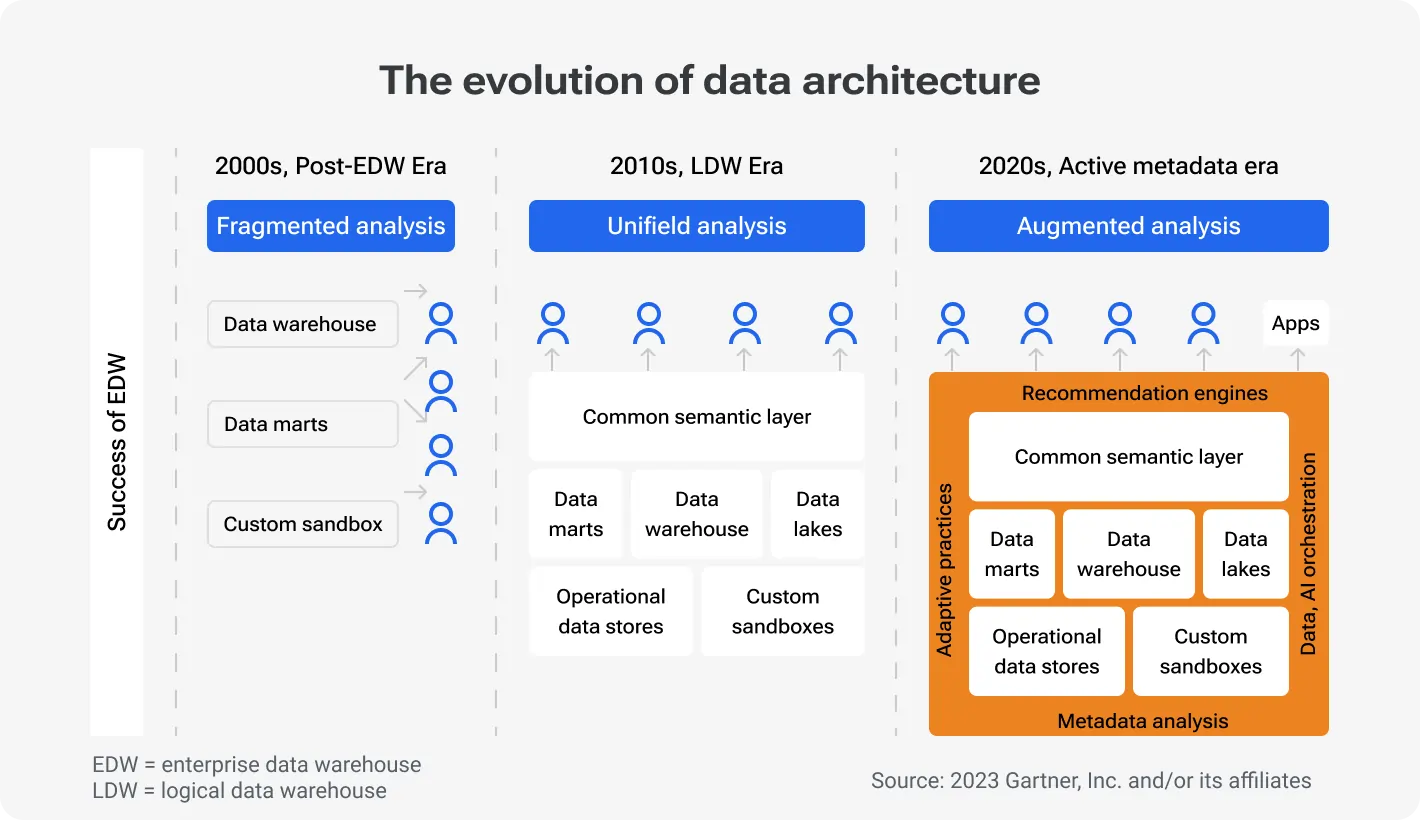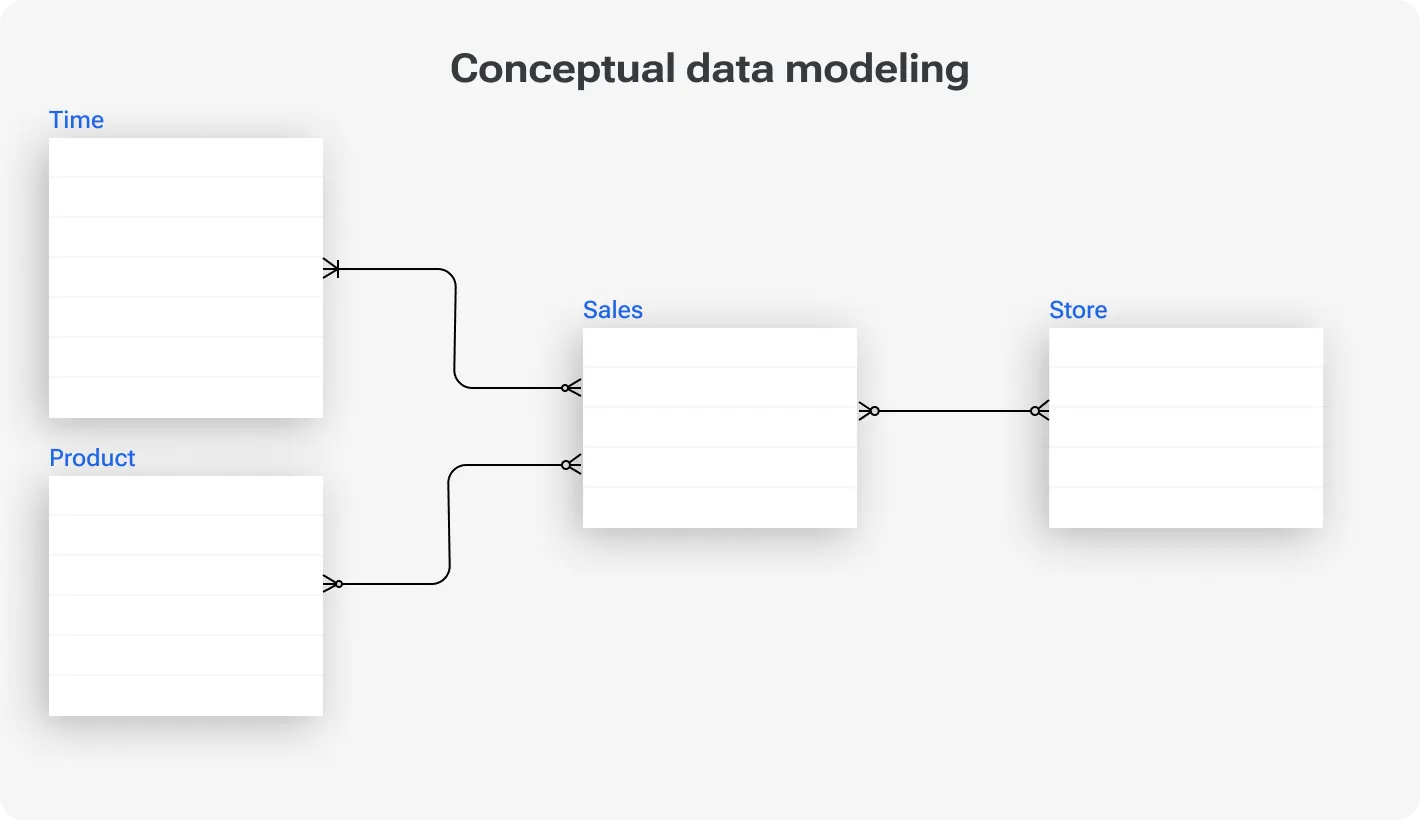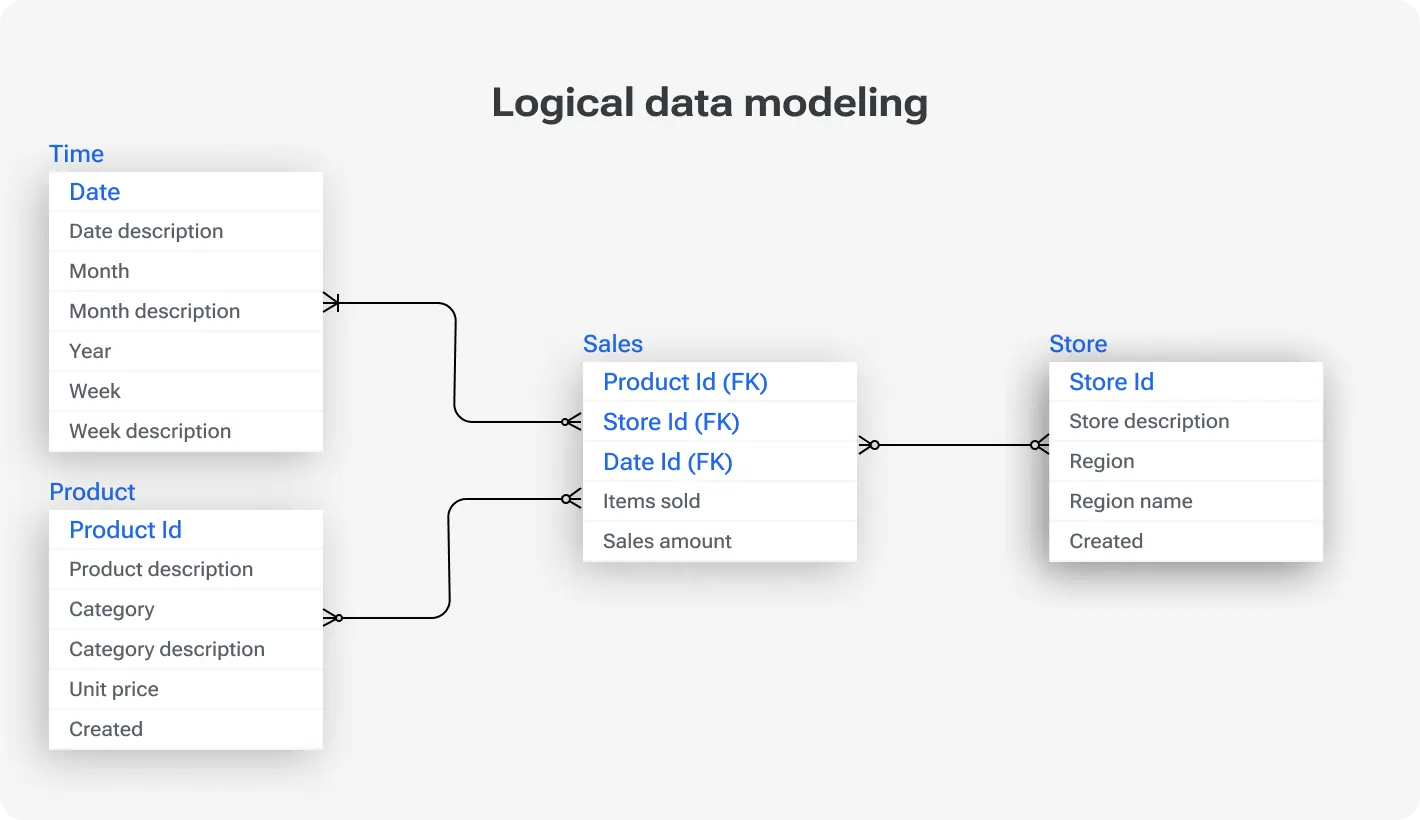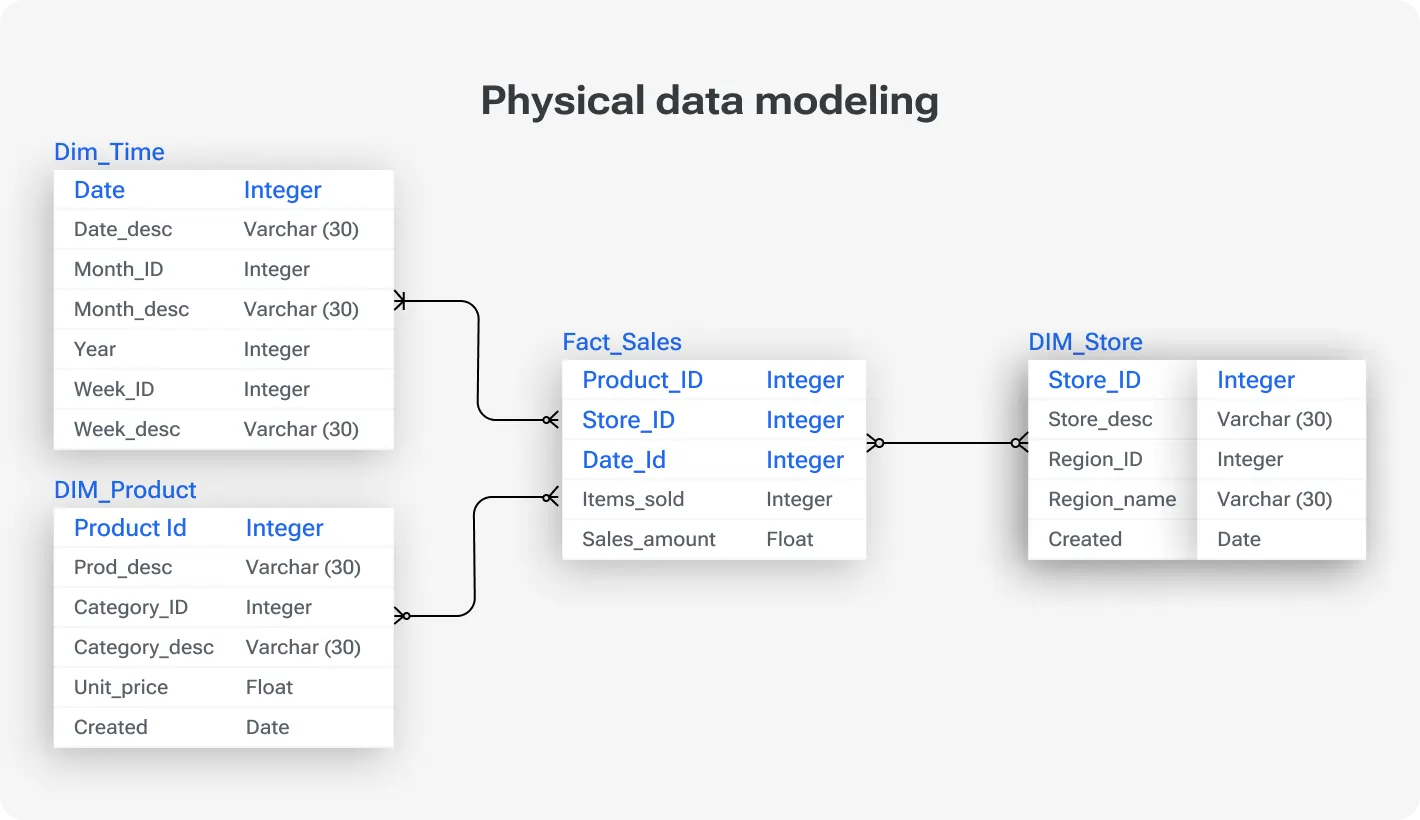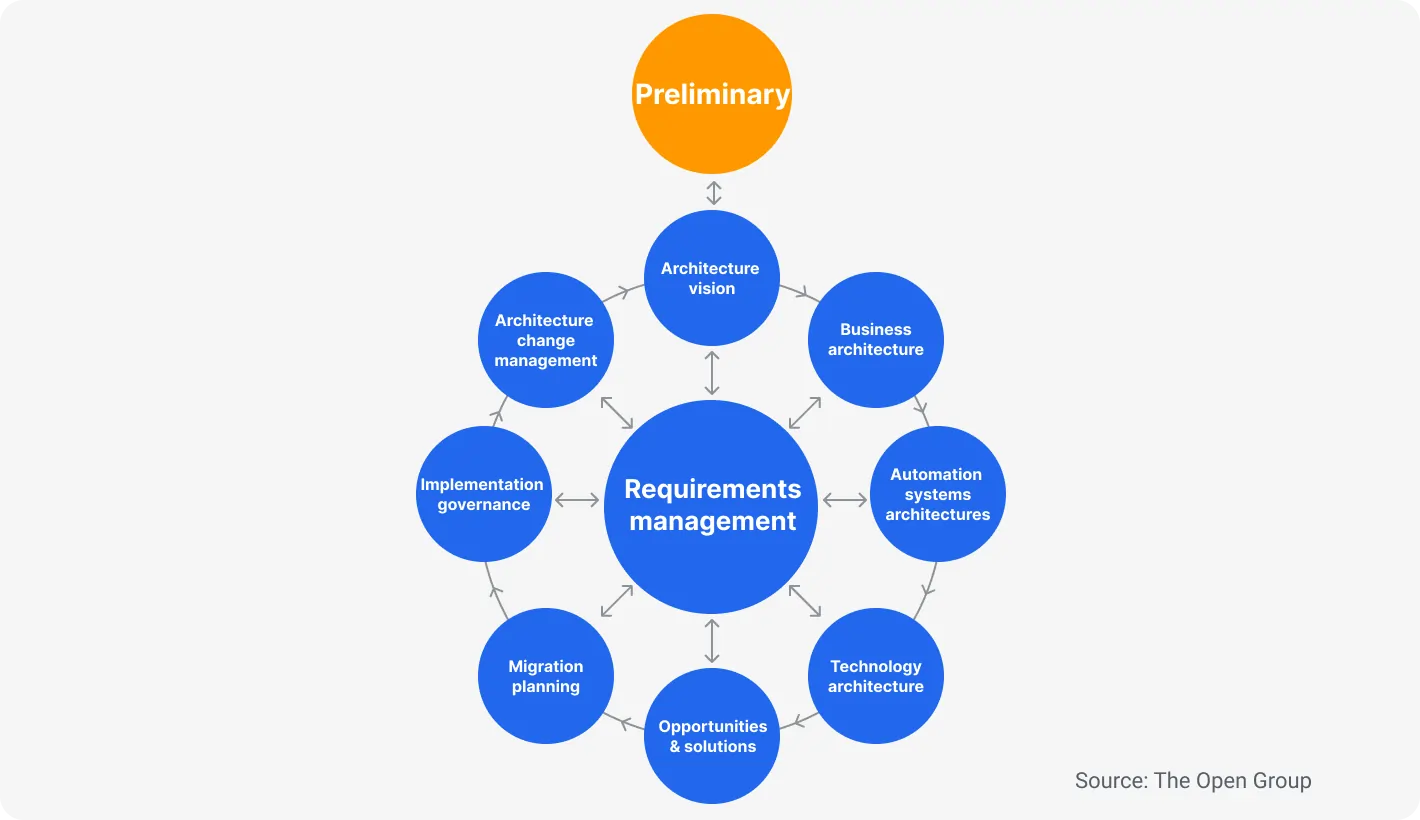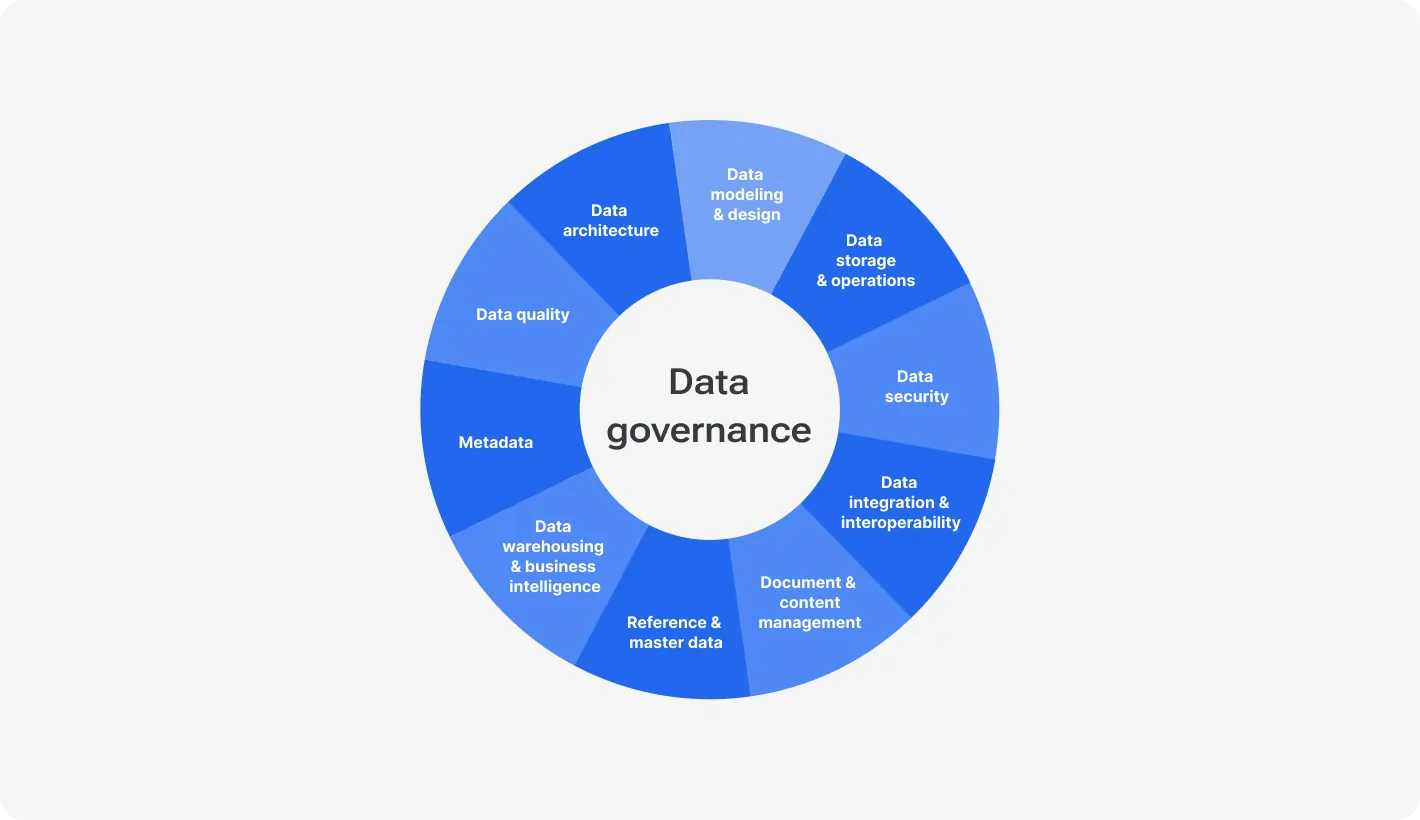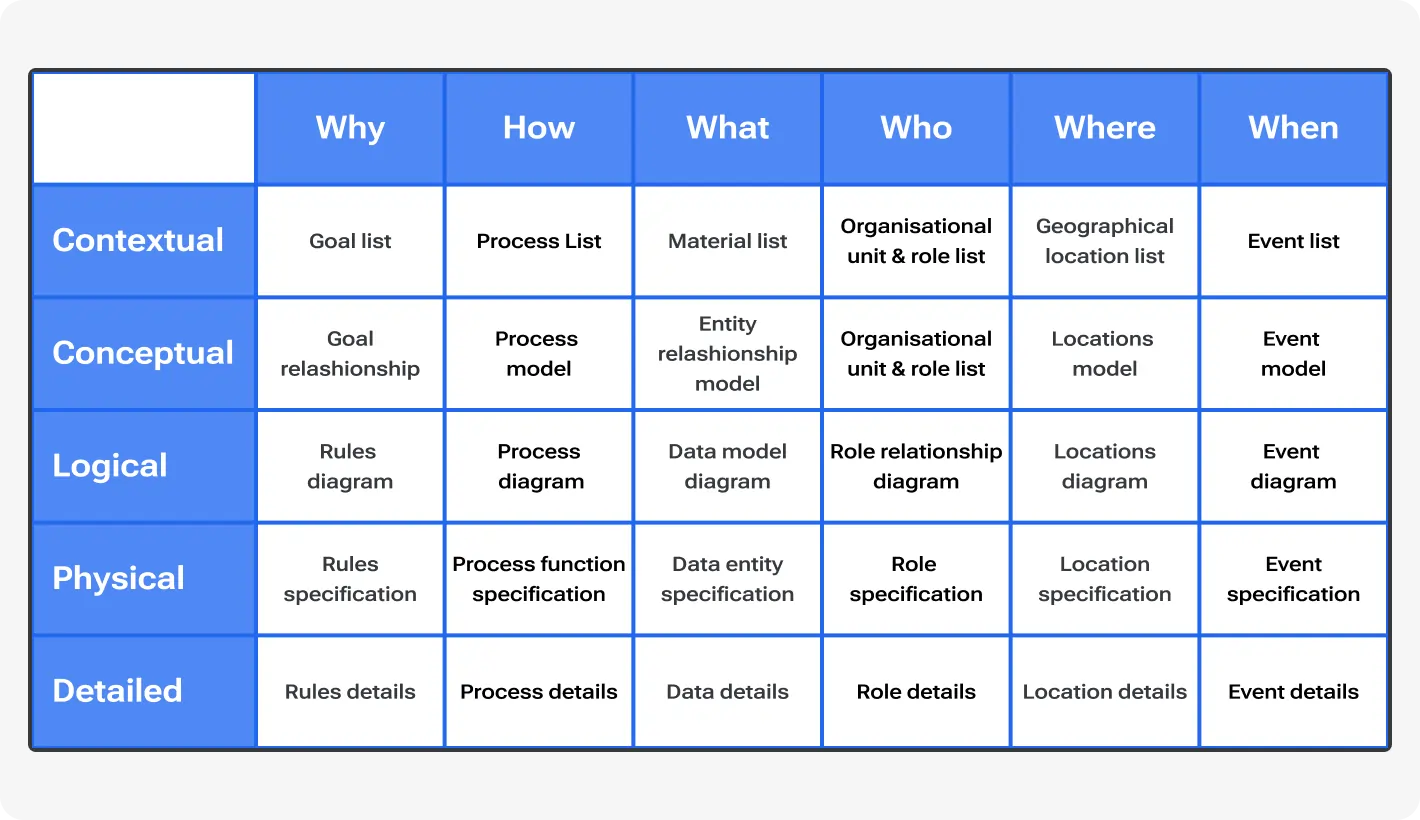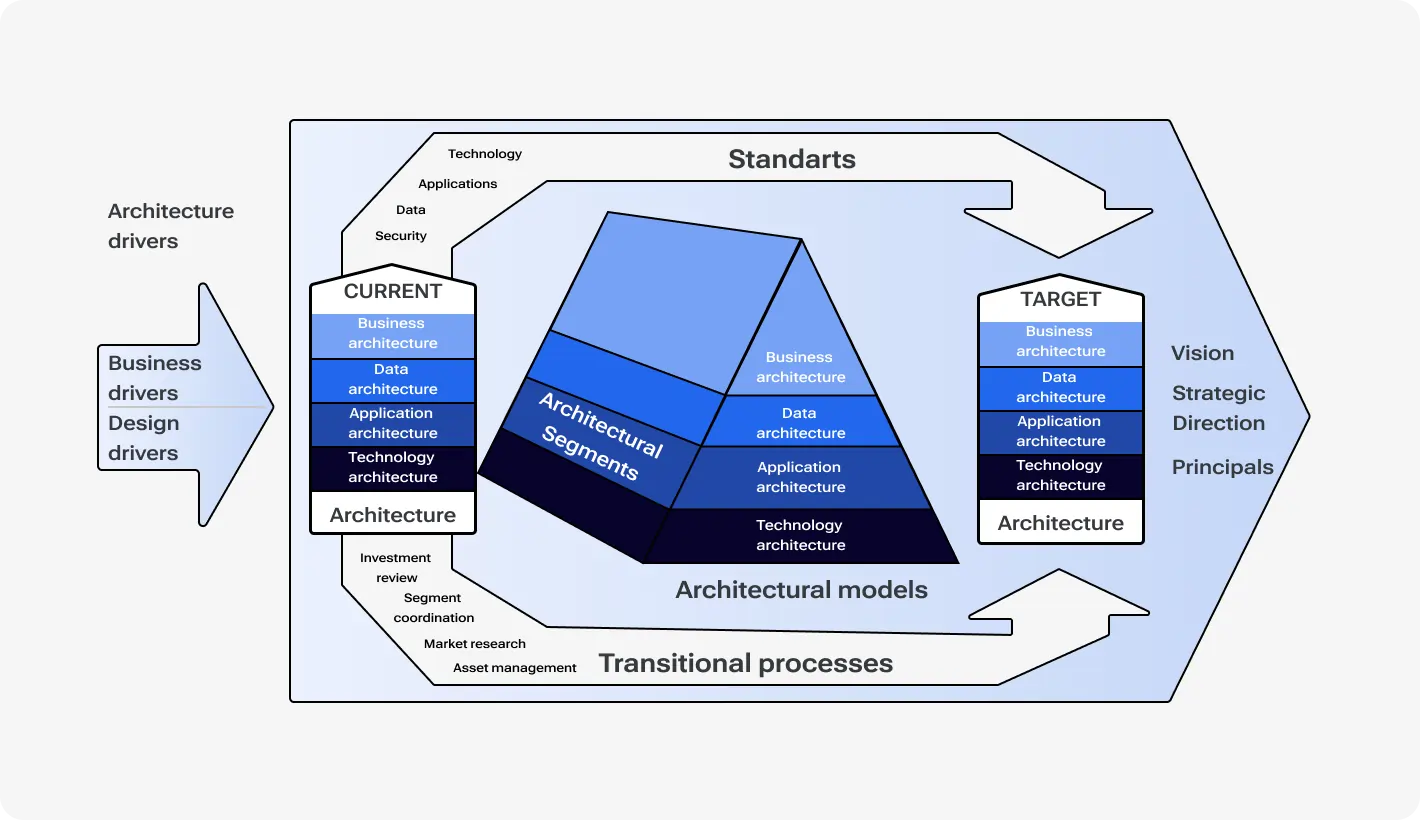Data has become the cornerstone of many businesses today: it helps to make more informed decisions, to change quickly according to market and user requirements, to gain a competitive advantage, and to succeed and become a leader in niches and industries. It sounds like a magic wand, only with a business slant, right? In fact, real success can be achieved by those companies that not only have data but know how to use it correctly and get as much benefit as possible.
This is where data architecture comes in. What is data architecture and why do you need it? In short, it's a blueprint that describes how data is collected, stored, analyzed, and used. Suppose now you think about the data strategy. In that case, you are right and wrong at the same time, because the data architecture is the basis of the data strategy and is the crucial foundation for effective data management in the company.
A well-designed data architecture helps to get a clear overview of the data that the company owns, to manage them productively and effectively, and to monitor in real-time the movement and use. First things first, let's start with the data architecture definition and dig deeper into its essentials.
Want to build a modern data architecture that drives innovation and business growth?
What is data architecture?
As we said above, data architecture defines how data is received, stored, and interacted in the company's ecosystem. It includes various components such as data management, data modeling, and data integration that work together to ensure efficient data operations.
From the first glance it may seem data architectures are too complex and require specialists to design and build. Well, to be honest, they are. However, we can look at it from the other angle.
Let’s imagine a company as a city. To function smoothly a city needs a well-designed infrastructure, the same as your company needs a robust data architecture to succeed in the data-driven business environment. While roads, bridges, and buildings form the backbone of a city, data architecture provides the fundamental structure upon which all data-related activities rest.
Data architecture evolution
Data management architecture has undergone significant changes over the years. It evolved from rudimentary systems of record to a strategic management tool. Initially, data architecture mainly served to organize and store data in structured formats for basic record-keeping and transactions.
As data volumes grew, and advanced technologies literally revolutionized the information environment, the role of architecture went beyond simple storage. Today, reliable and innovative data architecture management helps in making strategic decisions and getting a competitive advantage.
As per Gartner's analysis, the history of data architecture can be divided into several periods:
Pre-2000, the Era of Enterprise Data Warehouses (EDW) primarily revolved around the success and optimization of enterprise data warehouses.
2000 to 2010, Post-EDW Period witnessed a significant emphasis on analyzing fragmented data, with data warehouses serving as the cornerstone.
2010 to 2020, Rise of the Logical Data Warehouse (LDW) brings a transition toward a more unified approach to data analysis.
2020 and Beyond points towards augmented data analytics, leveraging a plethora of relevant data sources.
Key benefits of data architecture
Data architectures are constantly evolving and changing as new technologies and business needs emerge. While they need to be flexible and scalable, their benefits remain largely unchanged. Here are a few key ones:
Advanced decision-making process. According to McKinsey’s survey, 64% of B2B companies claim they aim to increase their investments in predictive analytics. However, the majority of them are not yet satisfied with their return on investments. With a more unified view of organizational data, decision-makers receive timely and accurate information.
One of the most successful data architecture examples, Coca-Cola Andina decided to build a data lake to cope with all the data they obtain every day. Using robust technologies they were able to increase analytics productivity by 80% and make more informed decisions based on reliable data, promoting joint growth of the entire ecosystem. It also helped them to innovate and leverage the power of artificial intelligence, machine learning, and other advanced capabilities.
Improved data quality. A well-designed data architecture ensures data integrity and consistency, allowing to reduce errors and redundancy. In this way, terabytes of redundant information are filtered out, preventing the formation of data silos.
Increased agility. It provides capabilities to quickly adapt to changing market demands, and facilitate seamless data integration and scalability.
Cost optimization. By optimizing data storage and minimizing redundancy, it is possible to optimize the use of resources, which leads to cost savings.
As it happened with Wyndham Hotels & Resorts, that transformed the way they interact with information through data architecture innovations. Their main goal was to enhance user experience, so they've had to process large amounts of data to get to know their customers. Due to transparent and well-designed architecture, they've got a 40% decrease in the time spent on managing their computing environment and were able to cut operational costs by migrating to AWS.
Improved data security. Thanks to robust security measures, data is protected from unauthorized access, ensuring confidentiality, integrity, and availability.
Improved innovation. With the flexibility and scalability of today's architecture, you can easily implement the latest technologies and options for displaying data.
While data architecture may seem like a must-have for large companies, it is actually a critical component of any company's data management. No matter what size or industry the organization is, transparent and efficient data processing is a key to leadership and success.
Exploring the building blocks: 7 major components of data architecture
To turn a complex business data architecture into a strong competitive advantage, it is necessary to understand how it works, what it consists of, and what exactly each component is responsible for. You've definitely heard these terms, but sometimes it can be quite difficult to tell the difference. So, what do you need to know about the main data architecture components?
-
Data governance involves establishing policies, procedures, and responsibilities. It helps to manage and ensure the quality, integrity, and security of data. Returning to the metaphor of the city, these are precisely the institutions that are responsible for laws and regulations. It defines rules and guidelines for data usage, access, and lifecycle management. It also ensures compliance with regulatory requirements and business objectives.
-
Data standards provide for the definition and application of agreed data formats, structures, and naming conventions. These are like communication and standardization departments in the city, which are necessary for easy and seamless interaction, data exchange, and integration between different systems and programs. This ensures consistency, accuracy and reliability of data.
-
Data modeling is responsible for creating conceptual, logical, and physical models to represent and organize data objects, attributes, and relationships in a database or data warehouse. This is like planning and zoning the city: there will be children's quarters here, business centers here, entertainment centers and parks here, etc. There is often confusion about data architecture and data modeling, and vice versa. While modeling takes place at the micro level, architecture allows you to see the whole picture. Data modeling allows stakeholders to visualize and understand the structure and semantics of data. This makes database design, application development, and decision-making processes easier.
-
Metadata management includes the collection, organization, and maintenance of metadata that provides descriptive information about data, such as their origin, classification, structure, and use. More like city information centers. It allows data discovery, lineage tracing and governance. And enables effective data management, analysis and decision support.
-
Data integration refers to the processes and tools used to extract, transform, and load data from various sources into a unified format. It resembles a city transport system, where different types of transport create a reliable ecosystem. It provides seamless data exchange, conversion and synchronization between different systems and applications. Most useful for business processes, analytics and reporting requirements.
-
Data warehousing & data lakes refers to physical or virtual data storage. These are centralized repositories for storing structured and unstructured data and managing them accordingly. Data warehouses are optimized for online analytical processing and reporting. It provides historical and aggregated data to support decision-making. Data lakes, on the other hand, accommodate a variety of data types and formats at scale. They are adapted for search analytics, machine learning and big data processing.
-
Data security includes implementing measures and controls to protect data assets from unauthorized access, disclosure, alteration or destruction. For example, application programming interfaces (APIs), data services, and query languages. This involves the use of access control, encryption, auditing, and monitoring mechanisms to protect sensitive information. Data security is also responsible for ensuring compliance with regulatory requirements and organizational policies.
Understanding the workforce: Different roles in data architecture
For successful data architecture management, you will need a team of specialists who understand the construction and maintenance of data processing. The size of the team may vary depending on your needs and current business plan, but there are a few key roles you should consider.
Data architects
A data architect is a sort of translator who converts business goals into technical requirements. His tasks include the design of data architecture, the definition of data standards and principles, creation of plans and roadmaps for data management. They are responsible for ensuring that data flows efficiently, is securely stored, and meets the organization's needs and goals.
There are several types of data architects that differ depending on the specifics of the architecture and how they work. For example, a cloud data architect works on the architecture of cloud platforms such as AWS and Google Cloud Platform.
Data engineers
Data engineers are true builders of data architectures. They create pipelines, data warehouses, databases, etc. Their ultimate goal is to make data accessible to other specialists, and hence, optimize performance and decision-making. Their task is to collect, manage, and convert raw data into usable information. They are also responsible for maintaining and supporting the whole ecosystem, and data security protocols implementation.
Data analysts
Data analysts are responsible for collecting, cleaning, and further analyzing information within an issue to be solved. Their step-by-step work allows them to select the necessary data, and with various tools and methods remove inaccuracies, repetitions, and excess. Thanks to this, they provide meaningful insight for further development and growth. For example, data analytics answers the following questions: what are the needs of the target audience, what advertising will be most effective with this age group, etc. They also visualize their results in graphs and charts.
Learn more about distinctions between data analytics and data science
Data scientists
Data scientist is another analyst position, but unlike the previous one, these specialists are innovators. They not only identify and determine future trends but also create new ways of data cleaning and analysis. They find new ways to solve the problem. Among their tasks can be:
Create tools and methods to extract information.
Assist in building automation systems to eliminate routine work.
Build data frameworks tailored to the company's needs.
Solutions architects
Solution architects create an overall technical vision of a specific solution to a business problem. While data architects dive deeper into the details of architecture, these specialists focus on the broader tech landscape. They design, describe and manage the solution. As a rule, this position is compared to a tech lead, because he stands, as it were, above everyone in the project and creates a general vision, a strategy for solving the problem.
Build your team wisely and keep in mind the capability for further scaling when your data volumes start to grow.
3-tiered approach to data modeling
In general, data models can be divided into three categories. Each of these data models is the next step to creating a functional system. In fact, this is a visualization of the data architecture, which allows you to easily follow connections and interactions between elements.
Conceptual data models
Conceptual models, or domain models, offer an overview of the content, organization, and business rules of a system. As a rule, they:
Define the types of things that are represented in the data model;
Specify their characteristics and limitations;
Show relationships between them and the corresponding data security and integrity requirements.
Logical data models
Logical data models show the ideas and relationships in more detail. Different formal methods can be used to draw these plans. They include details, like:
What type of data each item will have;
How they connect to each other, and more.
Important: these plans don’t specify technical requirements, and they might not always be made in some fast-paced development methods. They're useful for projects that focus a lot on data, like building databases or reporting systems.
Physical data models
Physical data models explain exactly how the data will be stored in a database. They're very detailed and provide a final design that can be used to make an actual database. They show:
These plans might also include technical details specific to the database system being used, like how to make it run faster, or so.
Cutting-edge frameworks: 4 pivotal data architecture frameworks
Data architecture frameworks are like guides that help organize and plan how to manage data in organizations. They provide a structured approach to the development and implementation of data processing solutions and ensure consistency and compliance with business goals. Here are four well-known ones:
TOGAF provides a structured approach to the design, planning, implementation, and management of enterprise architecture. It helps organizations align their IT infrastructure with business goals and improve decision-making.
DAMA-DMBOK2 is a comprehensive guide to data management techniques and principles. This is the second edition covering various aspects of data management. For example, data management, data quality, and data integration. This allows organizations a holistic view of data management best practices.
Briefly, the Zachman Framework is a classification scheme that organizes and describes the various perspectives of enterprise architecture. It provides a structured approach to understanding and analyzing complex systems, including data architecture, from multiple perspectives.
FEAF is a framework developed by the US federal government to guide the development and implementation of enterprise architectures across federal agencies. It helps ensure interoperability, information sharing, and efficiency of government IT systems.
These infrastructures are used as best practices to help standardize processes and improve the effectiveness of data architecture initiatives.
6-step guide to robust data architecture
Building a reliable and innovative data service architecture is not an easy task. So that you can overcome this challenge, we have compiled a small guide that will help you overcome bottlenecks and pitfalls easily and smoothly.
Step 1: Evaluate current tools & systems
Start by identifying where you are now, and what you have. Evaluate the existing structure, tools, frameworks, and other software used for data processing. Consider in essence how different elements interact, and try to find weak areas. Try to find pitfalls by talking to people that work with data. They can help you to plan necessary changes and improvements.
Step 2: Plan the data structure
Now you can move on to planning. At this stage you establish the very basis of your feature data system. Pay more attention to general things like how the data will be stored, who will have access to it and manage it. And don’t forget about particular data types and relationships between them. Additionally, consider data governance and security.
Step 3: Set clear business goals
Keep your business goals in mind. What you have to remember here is why do you do all this data architecture improvements and innovations.
You can implement general KPI recall specific metrics to measure the success of your actions. For example, to measure data-driven outcomes, such as improved performance or customer retention.
Step 4: Maintain proper data collection
Organize data collection. Your task is to guarantee data quality and integrity. It's time to think through and implement data validation and cleaning procedures. This will allow you. To easily and quickly detect different errors. Be mindful of compliance with industry standards and data privacy regulations.
Step 5: Choose reliable data visualization tool
Choose a data visualization tool that fits your needs and goals. It should be easy to use, scalable and compatible with your data architecture. You will have to create interactive visualization materials to explain complex data patterns and trends to stakeholders.
Step 6: Organize reporting & analysis
Focus on reporting and in-depth analysis. Apply different types of analytics to get valuable insights from your data. You can also use custom reports to provide stakeholders with relevant and timely information for decision-making. Consider implementation of automated analytical processes to simplify data analysis and reporting.
Feel free to adapt this guide to your needs, however, don't stray too far from the essential steps.
Key trends of data architecture
As mentioned above, the development of technology and business needs makes data architectures change. Here are some key trends that will shape the future of data management:
Cloud data architecture
Cloud storage is still the number one choice for many companies, as it is a scalable and cost-effective solution. Cloud data architecture provides the opportunity to store and analyze massive amounts of data without significant infrastructure investment. With cloud platforms like Amazon Web Services (AWS), Microsoft Azure, and Google Cloud Platform (GCP), organizations can reduce operational costs and fasten innovation.
Big data architecture
Big data analytics gradually becomes another must-have for successful companies. This has led to the development of specialized architectures capable of handling large volumes of structured and unstructured data. For example, Hadoop, Spark, and NoSQL databases allow companies to acquire, store, process, and analyze massive data sets. Through distributed computing and parallel processing techniques, big data architecture strategy lets companies get valuable insights from diverse data sources, hence, facilitate data-driven decision-making.
Real-time data architecture
Recently, real-time data architecture has become a critical requirement for organizations. Information is constantly updated and converged from many sources, such as mobile, IoT devices or social networks. A real-time data architecture allows to receive, process and analyze data in near real-time. Thanks to it, companies can be the first to introduce new trends or create services. Streaming frameworks (e.g., Apache Kafka, Apache Flink) and in-memory databases allow businesses to process high-speed streams of data and respond to events as they occur. Such an architecture is particularly valuable in the finance, e-commerce and telecommunications industries, where instant information can drive revenue growth and customer satisfaction.
To sum up
So, data architecture is your reliable foundation in working with large volumes of data. Clearly thought out, flexible and reliable, it will help you get the most out of information and improve decision-making. Using various tools and technologies, you can build a reliable blueprint of your success.
Developing and implementing a new or updating an old data architecture can be quite a challenge. Do not hesitate to consult with specialists or order a project to get the best possible result, tailored for your specific needs.
Make your data reliable now


